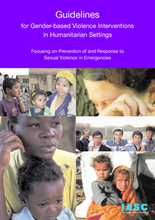During a crisis, such as armed conflict or natural disaster, institutions and systems for physical and social protection may be weakened or destroyed. Police, legal, health, education, and social services are often disrupted; many people flee, and those who remain may not have the capacity or the equipment to work. Families and communities are often separated, which results in a further breakdown of community support systems and protection mechanisms.
To save lives and maximise protection, a minimum set of activities must be rapidly undertaken in a coordinated manner to prevent and respond to gender-based violence from the earliest stages of an emergency. Survivors/victims of GBV need assistance to cope with the harmful consequences. They may need health care, psychological and social support, security, and legal redress. At the same time, prevention activities must be put in place to address causes and contributing factors to GBV in the setting. Providers of all these services must be knowledgeable, skilled, and compassionate in order to help the survivor/victim, and to establish effective preventive measures. Prevention and response to GBV therefore require coordinated action from actors from many sectors and agencies.
The primary purpose of these guidelines is to enable humanitarian actors and communities to plan, establish, and coordinate a set of minimum multisectoral interventions to prevent and respond to sexual violence during the early phase of an emergency.
While these guidelines focus on the early phase of an emergency, they also aim to inform and sensitise the humanitarian community to the existence of GBV during emergencies, that it is a serious and life threatening protection issue, and offer concrete strategies for including GBV interventions and considerations in emergency preparedness planning and during more stabilised phases of emergencies.
Three sets of activities are included in the guidelines:
1) overview of activities to be undertaken in the preparedness phase;
2) detailed implementation of minimum prevention and response during the early stages of the emergency; and
3) overview of comprehensive action to be taken in more stabilised phases and during recovery and rehabilitation.
©United Nations Inter-Agency Standing Committee

